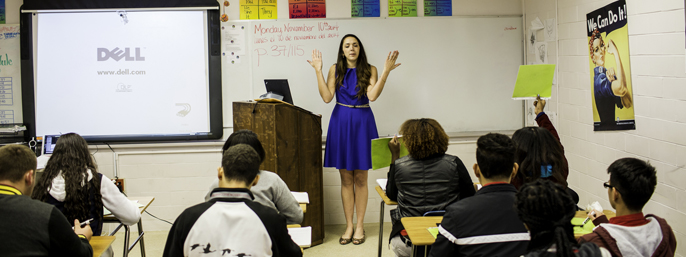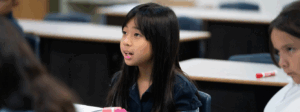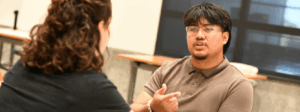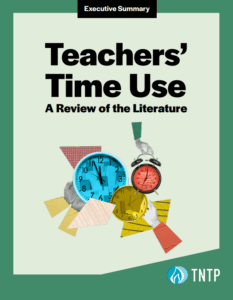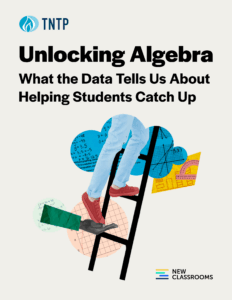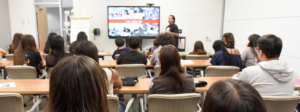I was unable to focus on my work back on February 10th. All I could do was continue to click on news articles about the tragic murders of three college students in Chapel Hill, North Carolina. Three college students who happened to be Muslim, like me. I was shaken at the realization that the stories I read could have easily been about me or any of my friends.
As I struggled to return to my duties, I thought to myself: How do you work productively when you feel like your world has shifted? Then I took a step back, reflected on my role at TNTP—and students across the country reading these very same articles—and thought: How do we expect our students to do the same when events at home, in their neighborhoods and in their cities influence them every day?
Understanding the world our students live in and how we may contribute to institutions of racism and power—without even realizing it—is essential to being an effective educator. So, when I recently had the opportunity to design a session on doing just that for a group of early childhood educators, I jumped at the chance.
As I designed the session, the big question for me and my team became: Where to begin? What would have the most tangible effect on teachers, classrooms and students?
As an organization, we’ve spoken about the importance of building culturally inclusive classrooms led by teachers who are conscious of the experiences and values both they and their students bring to the classroom. This doesn’t mean simply celebrating a heritage month or experiencing the food and music of another culture; rather, culturally inclusive classrooms are ones in which teachers are reflective of their own positions, assumptions and values that have developed as a result of their own life experiences. These teachers see their students as individuals—rather than as representatives of social or cultural groups.
We believe that culturally inclusive teaching helps engage students more effectively in their own learning and represents a step toward ensuring we are doing our part to actively break down the social and institutional imbalances of power that permeate our education system. But culturally inclusive teaching, just like understanding what content to teach or how to deliver the key points of a lesson, is a skill that’s developed. And building skills requires establishing a clear vision and giving teachers plenty of concrete practice opportunities and targeted feedback.
My team and I kept these principles in mind as we decided how to approach a three-hour starter training for teachers on topics that could take months to unpack. This meant taking stock of where our teachers were starting and setting clear priorities for what we wanted to accomplish, given the limited timeframe. We landed on three major goals:
- Analyze how culture affects different scenarios in early childhood classrooms.
- Identify ways to bridge cultures and empower students from different backgrounds.
- Understand what is culturally appropriate and determine multiple ways to implement culturally inclusive instruction.
In our session, the primary focus was to help teachers become more aware of their own cultural perspectives and assumptions and how these, in turn, affect student outcomes. This felt like the right starting place for many teachers who were never pushed to think deeply about their own personal values, their curricular choices, their students’ backgrounds and how all three relate.
We began by asking teachers to reflect on—and categorize—themselves based on their personal identities. For instance, what type of school they attended as a child, their birth order and their ethnicity. We used this activity to open up a discussion about assumptions educators can make about their students. We then looked at what it means to develop a culturally inclusive classroom by unpacking case studies, watching video reflections of teachers and completing a self-assessment where teachers identified how their mindsets influenced student actions and outcomes.
Many assumptions were unearthed. One teacher pulled me aside at the start and whispered, “I’m not sure why I have to be here. I grew up in the neighborhood where I teach.” But after spending a few hours analyzing how teacher mindsets can lead to biased actions, this teacher left our session saying, “I’m committed to questioning my mindset of being ‘all-knowing’ just because my students look like me.” Another reflected, “I'm teaching from a specific perspective. I need to be aware of my actions and how my students react to my actions. I think my students could achieve more if I expected more.”
Despite these successes, there were plenty of challenges and unexpected resistance. Perhaps the biggest challenge was finding ways to get concrete about what culturally inclusive teaching looks—and sounds—like in a variety of classroom settings. And for many participants, our content was new, while others felt like they’d already engaged in these topics. Navigating those different entry points in a short amount of time proved difficult. In retrospect, we would have narrowed our focus and prioritized depth over breadth, perhaps even choosing to focus on self-analysis in one session and delving into concrete practices in a separate session.
Nonetheless, the experience was worth it. Our participants proved that there is an appetite for this content among teachers. And the results lead us to believe, even more strongly, that there is a lot of work to do in order to build culturally inclusive classrooms for our students. We all must take a deep, critical look at the mindsets we bring to our work—in classrooms, schools and districts—on a day to day basis. Yes, this means asking difficult questions of ourselves and being brutally honest. But at the end of the day, if we’re not building schools with our communities and with our students, we aren’t doing our job.
